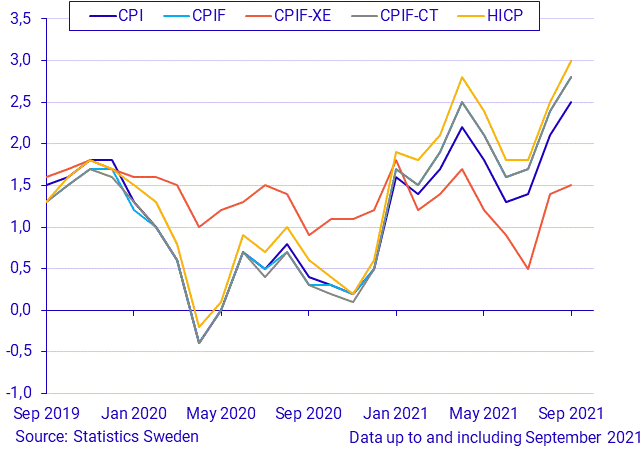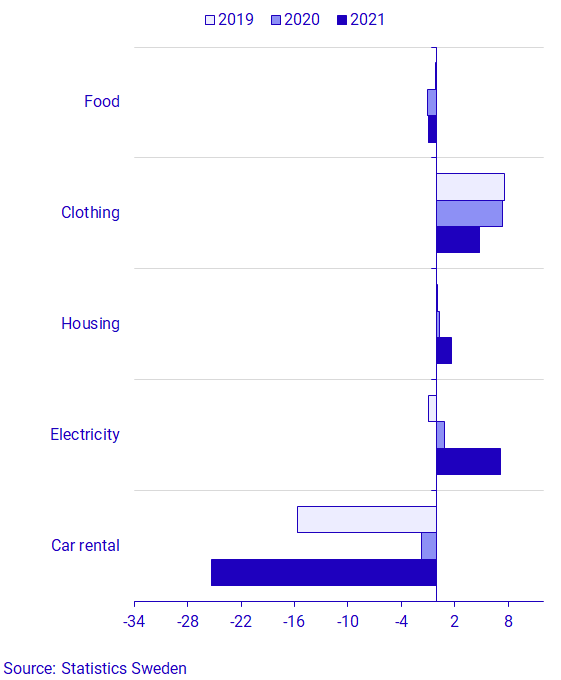Consumer Price Index (CPI), September 2021
Inflation rate was 2.8 percent in September 2021
Statistical news from Statistics Sweden 2021-10-14 9.30
The CPIF (Consumer Price Index with fixed interest rate) 12-month inflation rate was 2.8 percent in September 2021, up from 2.4 percent in August. On a monthly basis, the inflation rate according to the CPIF rose by 0.5 percent between August and September.
“The rate of inflation increased in September, largely due to rising electricity prices,” says Caroline Neander, statistician at Statistics Sweden.
In brief
| Index Numbers |
Monthly changes, percent |
Annual changes, percent |
|
|---|---|---|---|
| CPI (1980=100) | 345.74 | 0.5 | 2.5 |
| CPIF (1987=100) | 226.72 | 0.5 | 2.8 |
| CPIF-XE (1987=100) | 211.84 | 0.2 | 1.5 |
- Rising electricity prices in September affected housing costs
- The inflation rate was affected by higher fuel prices
- The highest inflation rate since October 2008
- No imputations related to the COVID-19 pandemic were made
- The inflation rate, according to CPIF excluding energy, increased from 1.4 percent to 1.5 percent
Rising electricity prices
The CPIF rose by 0.5 percent from August to September. In the corresponding period a year ago, the CPIF fell by 0.1 percent.
Due to eased pandemic restrictions, no product groups were imputed, neither in full nor in part.
The monthly change largely came from rising housing prices, mainly caused by higher electricity prices. The prices on clothing increased from August to September, which is normal for the season.
Car rental prices fell in September. Food prices also fell, mainly due to falling prices on meat, fruit and vegetables.
The table below shows changes on a monthly basis and contributions to the CPIF based on the goods and services that had the greatest impact on the CPIF in September 2021. The results are presented by COICOP category. COICOP refers to the United Nations classification of household consumption expenditure.
| Category (Coicop) | Monthly changes, percent |
Contribution to CPIF Monthly change, percentage points |
|---|---|---|
| Food (01.1) | ‑0.9 | ‑0.1 |
| Clothing (03.1) | 4.8 | 0.2 |
| Housing (04) | 1.6 | 0.4 |
| Electricity (04.5.1) | 7.1 | 0.3 |
| Other services in respect of personal transport equipment (07.2.4) | ‑11.4 | ‑0.2 |
Seasonal patterns and temporary price changes
Price changes on goods and services may be seasonal or temporary. The figure above shows the monthly changes this year and in the two most recent years for the goods and services with the largest impact on the CPIF monthly change.
Food prices fell in September, which is seasonally normal. The price decrease this month was slightly smaller than the price decrease in the corresponding period a year ago, but larger than the price decrease in 2019.
Clothing noted a seasonally normal price increase in September 2021, although it was slightly smaller than in the corresponding period in 2019 and 2020.
Housing costs rose significantly more in September 2021 than in the same period in the last two years. This development was mainly due to rising electricity prices. Electricity prices rose significantly more in September 2021 than in September 2020. In September 2019, electricity prices fell.
For car rental, the monthly change in September 2021 was negative. This was due to unusually higher car rental prices during the summer. The drop in prices in September closely resembled the pre-pandemic drop in prices in September 2019. In the same period in 2020, the drop in prices was smaller.
Contribution to the inflation rate in September
The inflation rate according to the CPIF, that is, the change in the CPIF over the past 12-month period, was 2.8 percent in September 2021, up from 2.4 percent in August.
This is the highest inflation rate since October 2008.
The rate of inflation was mainly affected by increased housing costs, in which electricity prices accounted for the largest contribution. The product group “Housing: Use of the home”, which includes depreciation, was also a factor that affected housing costs. Transport prices also increased, largely affected by fuel prices.
These price increases were offset by falling prices in the audiovisual, photographic equipment, and telecommunications equipment groups.
The inflation rate according to the CPIF excluding energy was 1.5 percent in September, up from 1.4 percent in August.
| Category (Coicop) | Yearly change, percent |
Contribution yearly change CPIF percentage points |
|---|---|---|
| Housing (04) | 6.4 | 1.6 |
| Electricity (04.5.1) | 23.7 | 0.9 |
| Transport (07) | 6.2 | 0.8 |
| Fuel (07.2.2) | 23.2 | 0.5 |
| Communication (08.2) | ‑14.1 | ‑0.2 |
| Audio-visual, photographic and information processing equipment (09.1) | ‑11.3 | ‑0.3 |
Other measures of inflation
Statistics Sweden calculates different inflation measures for different purposes. The CPIF is the Riksbank’s target variable, while the CPI is the measure used for purposes of compensation.

Effects of the coronavirus pandemic on calculations
Due to eased pandemic restrictions, no product groups were imputed, neither fully nor in part. For further information, see the document:
Definitions and explanations
The CPIF shows the same price trend as the CPI, but without the direct effects of a changed monetary policy. The CPIF is the Riksbank’s target variable for the inflation target.
The CPIF excluding energy (CPIF-XE) and the CPIF with constant tax (CPIF-CT) are two other measures of inflation produced by Statistics Sweden on behalf of the Riksbank. In the CPIF-XE, energy products are excluded from the CPIF, while in the CPIF-CT the taxes and subsidies associated with the products in the CPIF are kept constant.
The HICP (Harmonised Index of Consumer Prices) is produced by all EU Member States. This measure has a somewhat smaller coverage than the CPI and the CPIF, mainly because parts of households’ housing costs are omitted.
Next publishing will be
2021-11-15 at 9:30.
Statistical Database
More information is available in the Statistical Database
Feel free to use the facts from this statistical news but remember to state Source: Statistics Sweden.

